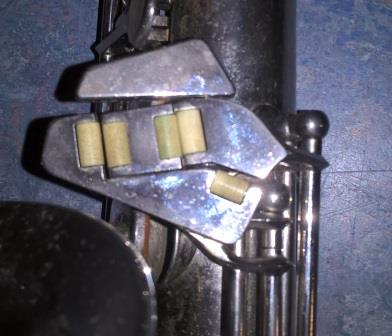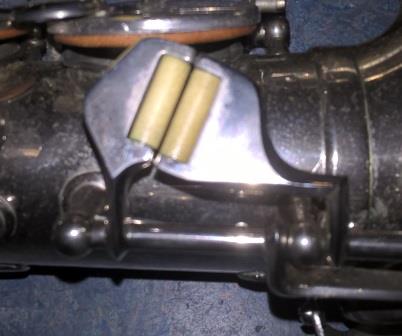 Schenkelaars saxofoons
Schenkelaars saxofoons
The Dutch musical instrument factory Schenkelaars was founded in 1928 by Harrrie Schenkelaars.
The brand is known worldwide due to the stencils they build like Concord.
Next to Kessels in Tilburg it was once the second largest musical instrument factory in the Netherlands.
There is a lot of uncertainty about the origin and quality of the Schenkelaars saxophones. On this page I collect the information I find here and there and I try to link the serial numbers to the origin.
Overzicht
History of the brand
Harrie Schenkelaars started selling wind instruments from Gebr. De Prins from Antwerp. He started his own factory on 11 April 1928 after he was able to recruit a former employee of the Mahillon company from Lier. They opened their own workshop on Willemstraat in Eindhoven and moved to Bleekstraat in 1934. Initially, trombones were built there, an instrument that Harrie himself also played. Later, horns, trumpets, tubas, clarinets and percussion were also made. In 1949, sons Gerard and Dulf and son-in-law Joop Brekoo became partners in the business. The name of the company probably became 'Schenkelaars Brekoo' around that time.
Business is going well, especially due to exports to America. The location on Bleekstraat had already become too small in 1953. That is why a new factory on Ruysdaelbaan was put into use. The saxophones were made in a location in Veldhoven.
Founder Harrie Schenkelaars passed away on 27 February 1979. His sons Dulf and Gerard and son-in-law Joop Brekoo took over the company. The successful company was sold to an investor (Albregts) in 1983, who sold it on to an American company a few years later. Dulf remained in the company as sales director Benelux. However, the new management did not manage to win the competitive battle. Due to differences of opinion, Dulf Schenkelaars withdrew in 1987. In November 1987, the company was declared bankrupt and the musical instrument factory had to close its branch in Eindhoven. Part of the company was continued in Best. Eventually, that company also went bankrupt. Music store Music All In bought the bankrupt estate and started manufacturing 'brass' under the name 'First Brass'. However, they also stopped production in the 1990s. The machines came into the hands of the Adams company in Thorn.
.
Schenkelaars saxophones
Own production
From the 1930s onwards, Schenkelaars made instruments themselves, but no saxophones yet. At that time, Schenkelaars were made by Beaugnier from France and later by Keilwerth from Germany. These instruments were then provided with the Schenkelaars logo. These instruments were purely handmade and heavy in weight and sound, but excellent for stable harmony and fanfare work. These saxophones were usually nickel-plated because this made them more resistant to outdoor use. These saxophones, especially the tenor, had a fairly short neck. This allowed you to hold the instrument close to your body while marching. Series of instruments were also made for the army. The models were provided with an army emblem (Je Maintaindrai). They are often high-pitched saxophones (see also Schenkelaars 1939)
Schenkelaars started manufacturing their own saxophones in 1949, Harrie Schenkelaars, who had a good relationship with Julius Keilwerth, hired his brother Josef Keilwerth. Joseph ensured a high-quality design of the saxophones. From then on, the alto and tenor saxophone models were based on the ideas of Julius Keilwerth. Soprano saxophones and baritone saxophones were purchased from Julius Keilwerth and provided with their own engraving (stencils).
Characteristic of the Schenkelaars are
- a left pinky plates with 5 rollers
- the circular connection between the bell and body with a post attachment on one side
- the ergonomic shape of the right pinky plate
- a rotating clamp ring on the neck receiver.




The concord line
From the fifties onwards, Schenkelaars produced the so-called Concord saxophone for the American market, as well as models with foreign-sounding names such as Kaiser F. Alexander and Lamonte superior. All saxophones were based on a body made by Keilwerth (including the Toneking IV) which was provided by Schenkelaars with its own keywork. Over the years, the keywork has changed somewhat, but the bore has always remained the same. The Concord has been marketed under various names, such as the Goldtone, Concord Artist, American Diplomat, Montclair, Chris Kratt, and this continued into the seventies.
Stencils
At the end of the 1960s, new engineers from Philips arrived at Schenkelaars with new marketing ideas. Schenkelaars could no longer meet the high demand. The production capacity was too small. Saxophones were increasingly purchased. First from Keilwerth, but later, to keep the price down, also from Arta Gubab in Romania, Dörfler & Jörka in Germany, Orsu in Italy and Yanagisawa in Japan. These stencils were engraved in-house and often also had their own serial number. Julius Keilwerth did not agree with this course of action. He therefore looked for another position and left the Schenkelaars company. That did not do the quality any good. When Schenkelaars decided to have stencils made by Yanagisawa, the quality improved, but that could not save the company. Schenkelaars never made its own baritones. They were almost always purchased directly from Keilwerth
Characteristics of the different series
.
Original Schenkelaars from the 50s and 60s
- Ring as Bridge between bell and body
- For a while rolled tone holes
- B and Bb key on the right side
- Key protector on the bell rectangular with rounded corners
- Left pinky plate with 5 rollers
- No Schenkelaars engraving on G# key.
- ergonomic right pinky keys
- Rotating clamp ring on the neck receiver
- serial number with 1x 3 and 1x 4 digits in the neck and on the body
- three and four point attachment key guards
- adjustable felt holders in key protectors
- good quality
Schenkelaars from the 70 and 80
- S/M brand
- Ring-shaped bridge between bell and body mounted on two posts
- drawn tone holes instead of rolled
- B and Bb keys on right side of bell
- Left plate with 5 rollers
- No Schenkelaars engraving on G# key.
- fixed neck screw
- serial number 5 digits
- sometimes a plastic right hand thumbhook
- rubber non-adjustable felt holders in key guards
- cheaper construction but still a good sounding horn
- machine engraving Schenkelaars on right side of bell
Keilwerth Toneking IV stencils eind jaren 70 en jaren 80
- 2 and 3 point connection for key guards
- round shape of the key guards
- professional quality
- symmetrical left pink plateau
Orsi stencils jaren 70
- The eye-shaped bridge between body and bell.
Rampone - late 70s
- a diamond shaped bridge between cup and body
- plastic right thumb rest (also seen on Keilwerth stencils)
Yanagisawa - late 70s
- The Yanagisawa models are stencils of original Yanagisawa saxophones like the T500
- carry a serial number from Yanagisawa itself
Serie nummer analyse
Many instruments mention a double number. A three-digit number and below that a four-digit number. The first number is an indication of a small series or order. The second is a serial number.
There is a saxophone with serial number 259 4986 and 97XXX is from the same generation. Apparently the number system changed during that period.
There is a Concord type with serial number 28XX from the year 1959. It is said that the last Concord types were made in 1977. The highest serial numbers I have found so far is 9634.
The production was about 380 saxophones per year. According to Dulf Schenkelaars I interviewed around 2010, the production in the 80s was indeed a maximum of about 400 to 500 per year. But due to outsourcing of large series to other manufacturers, that was sometimes higher.
A preliminary serial number list would then be something like this:
| Serie | Serial number | Year of production | Remarks |
| 1100 | 1931 | Serial number possibly from Keilwerth | |
| 1700 | 1932 | ||
| 2500 | 1933 | ||
| 3500 | 1934 | ||
| 5000 | 1935 | ||
| 7000 | 1936 | ||
| 9000 | 1937 | ||
| 11000 | 1938 | ||
| 13500 | 1939 | ||
| 16000 | < 1940 | Serial number possibly from Keilwerth | |
| 1 | 1948 | from here rough estimations | |
| 200 | 1949 | ||
| 400 | 1950 | ||
| 600 | 1951 | ||
| 800 | 1952 | ||
| 900 | 1953 | ||
| 1000 | 1954 | ||
| 1100 | 1955 | ||
| 1200 | 1953 | ||
| 1400 | 1954 | ||
| 78 | 1600 | 1955 | |
| 1900 | 1956 | ||
| 110 | 2200 | 1957 | |
| 142 | 2500 | 1958 | |
| 155 | 2800 | 1959 | |
| 169/139 | 3180 | 1960 | |
| 177/186 | 3560 | 1961 | |
| 3940 | 1962 | ||
| 4320 | 1963 | ||
| 259 | 4700 | 1964 | I have seen a concord with numbers 269 and 5179 and the engraving BD of ED artist of N.Y.C. '62. |
| 5080 | 1965 | ||
| 5460 | 1966 | ||
| 5840 | 1967 | ||
| 6120 | 1968 | ||
| 324 | 6500 | 1969 | |
| 6880 | 1970 | ||
| 7260 | 1971 | ||
| 7640 | 1972 | ||
| 8020 | 1973 | ||
| 8420 | 1974 | ||
| 8820 | 1975 | ||
| 9220 | 1976 | ||
| 9620 | 1977 | ||
| After this often serial numbers from the producing company |
Photo's of different instruments on our Dutch website
On our Dutch website there are a lot of examples with photo's of the different models:
Sources:
- Trompetmuseum
- Eindhoven encyclopedie
- Eindhoven in beeld
- Saxontheweb, with a big thank you to Milandro
- Interview with Dulf Schenkelaars, Anton Kobussen (http://www.royalkobo.nl/), Huub van Geffen who all worked at the Schenkelaars factory in Eindhoven of Best.








